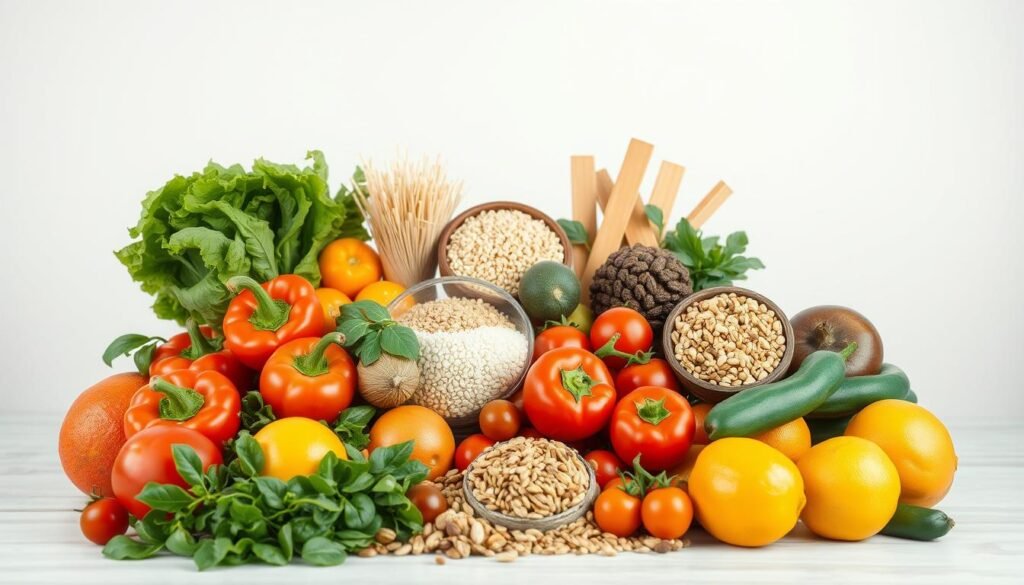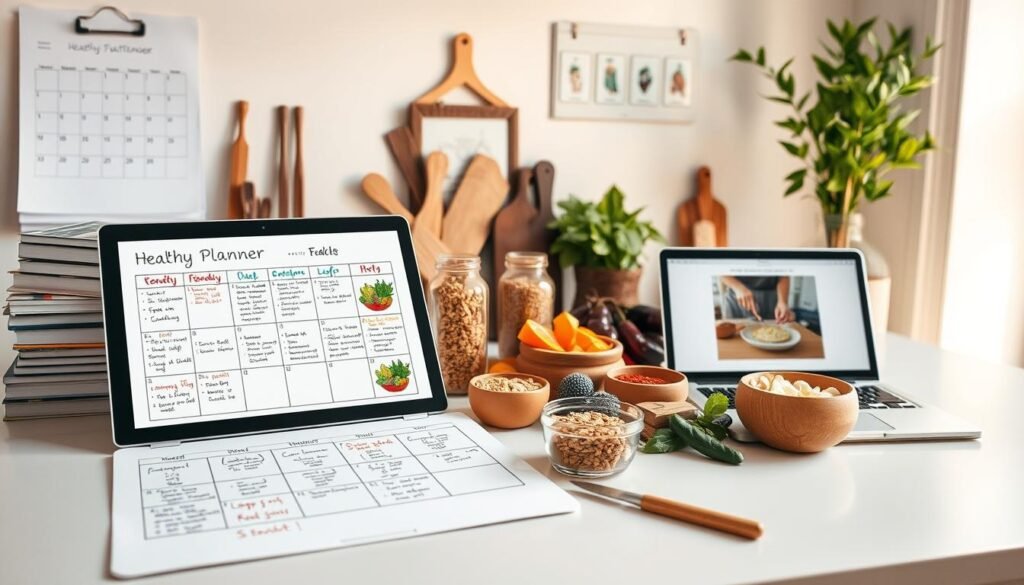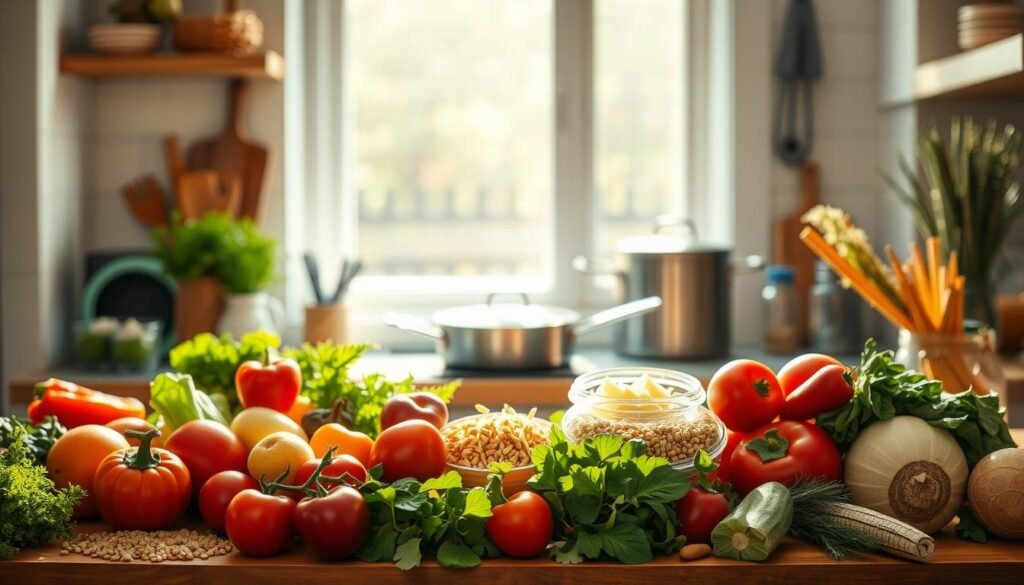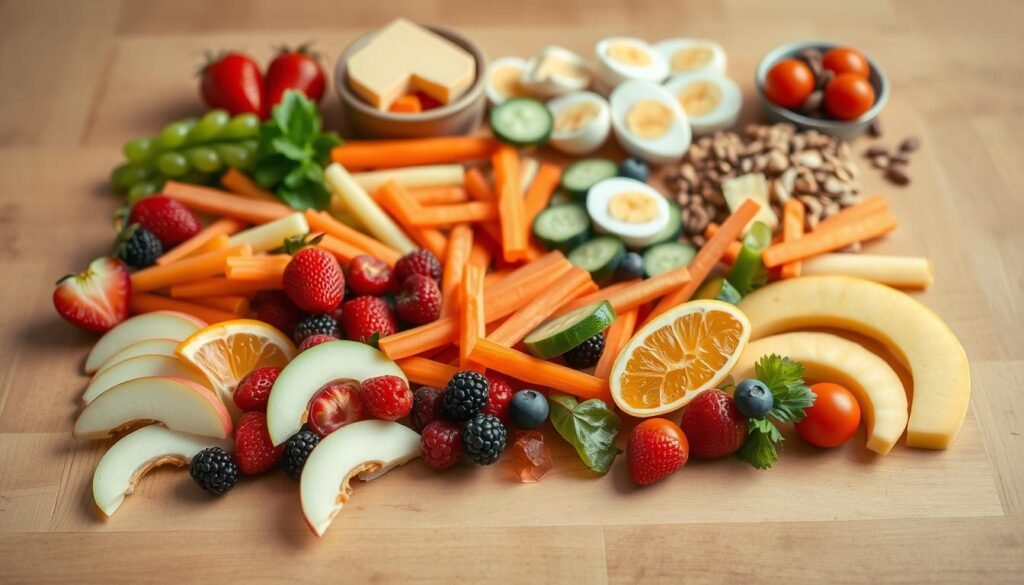Every morning, I look in the mirror and ask myself, “Am I fueling my body right?” For years, I juggled busy days with fast food and skipped meals. I realized my energy crashes and constant cravings were clues. The truth is, millions of us lack fiber, calcium, and vitamin D, key nutrients most Americans are missing, according to government guidelines.
When 70% of our sodium comes from packaged snacks and pizza, it’s easy to see why heart disease risks rise. Clean Eating isn’t about perfection—it’s small choices. Swapping butter for olive oil, or adding beans to tacos for a fiber boost, can make a big difference.
Even one homemade meal a week can build momentum. Nutrition isn’t one-size-fits-all. It’s about finding balance that fits your life, whether you’re prioritizing budget-friendly options or exploring global flavors. This guide will show how whole foods like colorful veggies, eggs, and avocado can turn everyday meals into fuel that fights disease and lifts mood.
Let’s start simple: your next grocery list could be the first step toward lasting change.
What is Healthy Eating?

A balanced diet includes foods like fruits, vegetables, whole grains, lean proteins, and low-fat dairy. The U.S. Department of Agriculture’s 2020-2025 Dietary Guidelines support this for long-term health. It also means avoiding too much sugar and unhealthy fats.
It’s recommended to limit sodium to under 5g daily and saturated fats to less than 10% of your calories.
Defining Healthy Eating
Healthy eating is more than a trend; it’s a lifestyle. The Mayo Clinic says it’s about variety and moderation. It involves:
- Eating more plant-based foods
- Keeping calorie intake balanced
- Reducing processed foods
- Choosing healthier fats
For example, using olive oil instead of butter is heart-healthy. A balanced diet also includes:
- Fruits and vegetables in 50% of meals
- Whole grains over refined carbs
- Lean proteins like fish and beans
Importance of Nutrition Labels
Nutrition labels guide us to make better choices. Look for:
| Check This | Why It Matters |
|---|---|
| Serving sizes | Prevents overeating calories |
| Sodium content | Excess can raise blood pressure |
| Sugar content | Less than 10% of daily calories |
WHO data shows 80% of heart disease cases are linked to bad diet choices. Reading labels helps avoid hidden sugars and unhealthy fats. For example, picking low-sodium soups can cut sodium intake by up to 40%.
The Benefits of Healthy Eating
I’ve seen how Healthy Eating brings big changes. Eating Nutrient-dense Foods gives you lasting energy and health. Let’s look at why these changes are so important.

Improved Physical Health
Studies show foods like spinach and salmon are good for your heart. The DASH diet, with its 1,500 mg sodium limit, helps lower blood pressure. Foods high in fiber, like oats and beans, can also reduce heart disease risk.
Staying away from trans fats can help prevent heart attacks. Eating balanced meals helps with weight management, leading to better long-term health.
Enhanced Mental Well-Being
A 2020 study found Mediterranean diets improve mood over processed foods.
B vitamins in greens help keep your mood stable. Omega-3s in sardines boost focus. Eating right also improves sleep and skin health.
Nutrient-dense snacks, like nuts and berries, keep your energy up all day.
Disease Prevention
I recommend eating more veggies and whole grains to lower cancer risks. The American Institute for Cancer Research agrees. Cutting down on sugary snacks can also reduce diabetes risk.
Calcium-rich foods, like kale and fortified milk, strengthen bones. Vitamin D from sunlight helps too. Eating nutrient-dense foods can also lower stroke and hypertension risks.
Essential Nutrients for a Balanced Diet
Knowing how nutrients work together is key. Most Americans don’t get enough fiber, calcium, vitamin D, and potassium. Eating nutrient-dense foods like leafy greens and whole grains helps. This way, you get what you need without too many calories.

Vitamins and Minerals
These tiny nutrients help with immunity, energy, and organ health. For instance:
- Vitamin C (oranges, peppers) boosts immunity.
- Iron (spinach, lentils) prevents fatigue.
- Calcium (dairy, fortified plant milks) strengthens bones.
Lacking these can lead to tiredness, weak bones, or slow healing. Whole foods are better than supplements for better absorption.
Proteins, Carbs, and Fats
Macronutrients give us energy and structure:
- Proteins (beans, poultry): 10-35% of calories) build muscles and enzymes.
- Carbohydrates (oats, quinoa: 45-65% of calories) fuel the brain and muscles.
- Fats (avocados, nuts: 20-35% of calories) protect organs and support nutrient absorption.
Choose unsaturated fats from nuts and olive oil over saturated fats in fried foods. It’s important to find a balance. Don’t cut out any macronutrient completely.
Eating foods like salmon (omega-3s) and broccoli (vitamin K) together is beneficial. The USDA suggests keeping added sugars under 10% of daily calories to avoid obesity. Try swapping sugary snacks for yogurt or carrot sticks for better nutrition.
How to Create a Healthy Eating Plan
Starting with Meal Planning and Weight Management is easy. First, track what you eat to see where you can do better. Try to have 50% of your plate filled with veggies, as the USDA suggests. Don’t worry if it feels like a lot at first.

“Half your plate should be fruits and vegetables,” advises Harvard’s Healthy Eating Plate.
Here’s how to make a plan that’s just for you:
- Start with small goals, like adding a new veggie or cutting down on sugary drinks.
- Choose meals that feature fresh, in-season produce to save money and get better taste.
- Use containers to control how much you eat when you prep meals.
| Option | Traditional Meal | Healthy Alternative |
|---|---|---|
| Steak Dinner | 1,500 calories | 700 calories (grilled steak + veggies) |
| Breakfast | 700 calories (eggs + sausage) | 400 calories (fruit + whole grains) |
Use apps like MyFitnessPal to keep track of your progress. Remember, it’s okay to have treats sometimes. Focus on eating whole grains and lean proteins like beans or salmon. Adjust how much you eat based on how active you are. Adding water and eating mindfully can help you stick to your Weight Management goals.
Smart Grocery Shopping Tips
Smart grocery shopping is key to Clean Eating. Start by planning to buy Whole Foods and avoid impulse buys. Make a list of meals for the week and the ingredients you need. Here’s how to make your list into a nutrition-packed haul:
“Buying ‘in season’ produce can cost less and offer peak flavor.”
Making a Healthy Grocery List
- Use seasonal produce guides to find cost-effective Whole Foods. Frozen berries or spinach work year-round.
- Opt for whole grains like brown rice or quinoa instead of refined carbs.
- Compare unit prices: A 6 oz yogurt at $0.72 has a unit price of $0.12/oz—check this to save money.
Navigating the Supermarket Safely
Start by visiting the store’s perimeter. This is where you find fresh produce, dairy, and meats. When you go into aisles, look for:
| Section | Smart Choices |
|---|---|
| Produce | In-season fruits/veggies, pre-washed greens |
| Dairy | Low-fat milk, plain yogurt (add your own fruit) |
| Canned Goods | No-salt-added veggies, beans in BPA-free cans |
| Frozen | Unseasoned veggies, wild-caught frozen fish |
Reading labels helps save money and calories. Choose products with Whole Foods listed first in ingredients. Stay away from aisles with sugary snacks to keep on track with Clean Eating goals.
Overcoming Common Healthy Eating Challenges
Healthy eating goals can face hurdles like cravings or dining out, but practical strategies make Mindful Eating and Weight Management achievable. Cravings often stem from habit or emotions, not hunger. Tackling them requires proactive steps.
Dealing with Cravings
- Keep healthy snacks nearby: nuts, fruit, or yogurt curb urges without derailing progress.
- Drink water first—thirst is often mistaken for hunger.
- Choose small portions of indulgences to avoid guilt, like a single square of dark chocolate.

Eating Out Mindfully
Restaurant meals can sabotage efforts, but mindful choices help. Opt for grilled, baked, or steamed dishes over fried options. Request sauces on the side to control portions. Share entrees or ask for a to-go box upfront to avoid overeating.
| Smart Choices | Why It Helps |
|---|---|
| Salad with grilled chicken | Low-calorie base with protein |
| Steamed vegetables | Retains nutrients, fewer additives |
Pairing Mindful Eating with portion control supports Weight Management. Apps like MyFitnessPal track intake, while programs like the USDA’s Spend Smart-Eat Smart offer affordable, healthy recipe ideas. Remember, progress isn’t perfect—focus on balance, not perfection.
Incorporating More Fruits and Vegetables
Adding Clean Eating staples like fruits and vegetables boosts Nutrient-dense Foods intake. Research shows each daily serving lowers cardiovascular disease risk by 4%. The American Heart Association recommends half your plate be produce. 
Seasonal Options to Explore
Seasonal produce is fresher and cheaper. Try these picks:
- Spring: Asparagus, strawberries, rhubarb
- Summer: Berries, corn, tomatoes
- Fall: Apples, pumpkin, Brussels sprouts
- Winter: Citrus, root vegetables
Canned or frozen options count toward your 4½-cup daily goal. Look for no-salt/no-sugar-added versions.
“Following a diet rich in fruits and vegetables reduced systolic blood pressure by 11 mm Hg in high-blood-pressure patients.”
Easy Ways to Add Them to Meals
Small changes make a big difference:
- Add spinach to smoothies or omelets
- Top salads with berries or apples
- Swap half your pasta for zucchini noodles
- Microwave broccoli with garlic and olive oil as a side
Studies show eating 8+ servings daily cuts heart attack risk by 30%. Even small steps like blending veggies into soups or snacking on apple slices with almond butter help. Prioritize non-starchy choices like broccoli and leafy greens for cancer prevention benefits.
Healthy Cooking Techniques
Switching to smarter cooking methods is key to Healthy Eating. These techniques keep meals flavorful while preserving nutrients. Let’s explore how simple changes in the kitchen boost your diet.

Baking vs. Frying
Baking uses dry heat, slashing oil use. For example, substituting refined flours with whole wheat or oat flour adds fiber without sacrificing taste. Frying, on the other hand, soaks food in oil, boosting calories. Here’s the breakdown:
| Method | Fat Used | Calorie Impact |
|---|---|---|
| Baking | Minimal or no oil | Lower due to dry heat |
| Frying | Oil-heavy (e.g., vegetable oil) | Higher from oil absorption |
Grilling and Steaming Tips
Grilling and steaming lock in nutrients. Try these tricks:
- Marinate proteins with herbs like garlic or rosemary to enhance flavor naturally.
- Steam broccoli or carrots in a bamboo steamer for 5-7 minutes to retain vitamins.
- Use a grill pan for indoor cooking or opt for fish like salmon rich in omega-3s.
The Clean Eating philosophy aligns with these methods. The USDA’s 2020-2025 guidelines recommend limiting saturated fats, achievable through these techniques. Swap frying pans for baking trays and enjoy crispier veggies without oil. Small swaps make big differences—your meals stay delicious and nutritious.
Quick and Healthy Snack Ideas
Maintaining a  Whole Foods Market has great options like air-popped popcorn. It has 100 calories in 3 cups and is full of whole grains and fiber. Eating smart snacks helps keep hunger and blood sugar in check, studies show.
Whole Foods Market has great options like air-popped popcorn. It has 100 calories in 3 cups and is full of whole grains and fiber. Eating smart snacks helps keep hunger and blood sugar in check, studies show.
Nutritious On-the-Go Snacks
- Pair 1 large red bell pepper with ¼ cup guacamole for under 200 calories.
- Opt for 1 cup edamame (18g protein) or 5 celery sticks with cream cheese (100 calories).
- Choose beef jerky with
DIY Snack Recipes
Create nutrient-rich combinations at home:
- Cucumber Sushi Rolls: Layer hummus, thinly sliced veggies, and tuna for a protein-packed bite.
- Protein-Packed Bowls: Mix cottage cheese (25g protein) with nuts and fruit.
- Vegetarian Crunch: Bake tofu nuggets or make crispy cauliflower bites in an air fryer.
Remember, portion control is key—stick to 1-ounce nut servings to avoid too many calories. Choose snacks like Greek yogurt with berries or peanut butter banana smoothies for a quick protein boost. With these ideas, keeping a balanced diet is easy and enjoyable.
Delicious Healthy Recipes to Try

Meal Planning just got easier with these nutrient-packed recipes made with Whole Foods. Each option balances taste and nutrition, perfect for every meal. Let’s dive into options that work for keto, vegan, or gluten-free diets.
Breakfast Ideas
- Cranberry Pumpkin Muffins: Use canned pumpkin and whole-grain flour for fiber and antioxidants.
- Pumpkin Pudding: Whisk coconut milk and spices for a creamy dessert with no added sugar.
Lunch and Dinner Options
For quick lunches, try Cheesy Bacon Ranch Chicken (ready in 25 minutes) or Sweet & Sour Tofu with a tangy glaze. Dinner favorites include:
- Mediterranean White Bean Chili: Canned beans cut prep time by 50%.
- Butter Beans Alla Vodka: Creamy and protein-rich at 15g per serving.
Guilt-Free Desserts
Swap refined sugars for dates or applesauce in recipes like:
- Pumpkin Pudding: Blend with chia seeds for a 20g protein boost.
- Dark Chocolate Chia Pudding: Soak overnight with almond milk for a no-cook treat.
| Recipe | Prep Time | Highlights |
|---|---|---|
| Cheesy Bacon Ranch Chicken | 25 mins | Gluten-free, 30% more veggies |
| Butter Beans Alla Vodka | 20 mins | 15g protein, vegan option |
| Mediterranean White Bean Chili | 30 mins | Uses canned beans, 20 unique recipes tested |
These recipes use Whole Foods to simplify meal planning. Swap cottage cheese for ricotta in salads for 20% more protein. All options are tested for ease and flavor, proving healthy eating can be quick and satisfying.
The Role of Hydration in Healthy Eating
Hydration is key to Healthy Eating and Nutrition. Water makes up 50% to 70% of our bodies, helping with every function. It aids digestion, nutrient absorption, and boosts energy levels.
Without enough water, our metabolism slows down, and we lose focus. Even a little dehydration can cause headaches and fatigue. This can really disrupt our daily lives.
“Adequate fluid intake is vital for bodily functions and supports Healthy Eating goals.” — U.S. National Academies of Sciences, Engineering, and Medicine
Importance of Water Intake
Water keeps our bodies in balance. The U.S. suggests men drink 15.5 cups (3.7 liters) and women drink 11.5 cups (2.7 liters) daily. These amounts change based on how active we are and where we live.
Even foods like watermelon or celery contribute to our fluid intake. Using a marked bottle to track water helps us stay on target.
Creative Ways to Stay Hydrated
- Mix lemon, cucumber, or berries in water for flavor without added sugar.
- Drink herbal teas or sparkling water to switch up routine hydration sources.
- Eat hydrating foods like soups, yogurt, or melons to boost fluid intake naturally.
Try to avoid sugary drinks, as they add calories but no Nutritional value. Choose low-sugar options and listen to your body’s thirst. Adjust how much you drink when you’re exercising or in hot weather to avoid dehydration’s effects on mood and energy.
Building a Support System for Healthy Eating
Healthy habits grow with support. Over 70% of people stick to their goals when they share them. Look for groups that focus on mindful eating or meal planning.
Local wellness centers and online sites like Meetup have cooking classes and recipe swaps. These help keep you motivated.
Finding Healthy Eating Community Groups
Search for mindful eating groups or meal-planning workshops. These communities offer tips and keep you accountable. Cooking clubs, for example, can increase vegetable intake by 50%.
Online forums also help, reducing social media’s negative effects. They can improve diet adherence by 25%.
Engaging Family and Friends
Getting loved ones involved boosts your commitment. Meal planning with a partner or child creates shared goals. Setting “no food zones” at home can cut snacking by 40%.
Sharing recipes on Pinterest or Instagram keeps motivation up—78% of users say it helps. Talking openly about food choices can prevent tension at social events.
